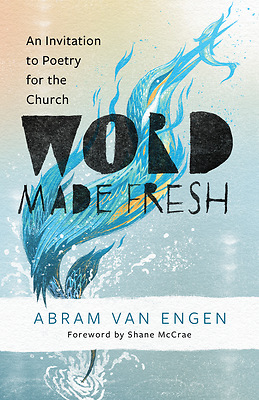A Review of Word Made Fresh by Abram Van Engen, Eerdmans 2024

A master teacher and scholar, Abram Van Engen teaches poetry in congregations. He is a missionary of poetic arts. His purpose, methods, and motivation are equally suited to classrooms of senior English students, especially those in Christian schools.
Van Engen explores forty poems, traditional as well as modern, and reveals the riches they offer. Always encouraging rereading and never insisting on finding a message, he invites readers (and listeners) to let poems do what they do.
What Poems Can Do
What poems can do, even when they may be initially confusing, is refresh and enliven language, eliciting from the reader new perceptions, nuances, and insights.
One of the first poems Van Engen discusses is “As Kingfishers Catch Fire” by Gerard Manley Hopkins. He recounts how struck he was on first discovering this poem as a fifteen year old. It confused and also fascinated him. It spoke to him as he was held by the sound of the words. His heart was stirred: it was a resonant moment. By rereading with close attention, gradually he discovered it has many layers, including a theological dimension.
When teaching the poem, Van Engen does not start with “what the poem means” but with asking if the reader/student finds a connection. If so, is it strong enough to want to reread and learn more? If not, his advice is to leave it but keep reading other poems to find those that connect with personal experience.
Just Start and Keep Going
Why do so many Christian readers avoid poetry? Van Engen asks. Though they are familiar with the poetry of the Scriptures—that of psalmists, prophets, wisdom teachers, gospel and epistle writers—poetry is not valued. Van Engen suggests that it is in part because people believe it cannot speak to them. They find it puzzling and irrelevant. Poems are as relevant as the life experiences readers can bring to them. Every reader, whether an adult in a church or a teen in class, has unique life experience. Not all poems will connect with all. We shouldn’t struggle over it. There are so many more poems waiting. When you experience the resonance between yourself and the poem, pay attention; it’s a gift.
Readers do not have to “understand” a poem to appreciate it. Do we fully “understand” the opening of John’s gospel or the powerful images of Revelation? Using linear, rational skills to explicate destroys the depth of imaginative writing. As Van Engen takes on a more thorough reading of the layers of background, form, and theological import, he demonstrates how worthwhile it is to do some patient “digging deeper.”
How should one read a poem? Just start—any way will do. “No fancy sword swings back and forth to guard the entrance,” he notes (22). Some words, a line, or an image will go directly to the heart; they surprise and delight. It is a moment of resonance.
What Is Christian Poetry Anyway?
George Herbert, the seventeenth-century devout Anglican priest and poet, is one of Van Engen’s favorite “friends.” Van Engen encourages approaching poems as friends. This befriending is a pleasure, though it may also be challenging in the way some friendships are. Van Engen discusses four of Herbert’s poems without didacticism.
When we engage poems as friends, they begin to speak in new ways. Herbert’s poems do not preach; they entice. Readers who approach Herbert’s work for delight find it also reveals the wounds of our hearts and opens us to mercy.
The pieces Van Engen discusses with his adult learners in a church building are not all by Christian writers or on Christian themes. Instead, he shows how a poet like William Carlos Williams invokes awareness of the same concerns that Milton did in Paradise Lost.
What is “Christian poetry” anyway? It can’t be limited to writers of faith who may be good or poor poets. Nor can it exclude writers of other faiths or no faith whose work shows profound awareness of sin, goodness, redemption,and community. There is no clear distinction in good writing between sacred or secular writing. No poem will be experienced by students in exactly the same way. Good writing prompts divergent responses. Poetry truth and the Christian truth are not in competition.
Philip Larkin’s famous poem “Church Going” describes a non-believer who often enters into empty old churches just to look as a tourist with a critical and bored eye. Wondering what, if any, use “this special shell” still has, he’s pleased to just stand in the silence. Nevertheless, he admits it’s a “serious house.” The last lines admit an awareness that he has “a hunger in himself to be more serious.” Van Engen comments, “The effects of this poem matter beyond any intention of the author” (33). Larkin was an ardent atheist, yet there is an awkward reverence. Van Engen reads it personally. It evokes strong memories for him of childhood experiences of worship in churches—the hymns, the community—and, like Larkin, he feels “compelled to return often to a place that takes seriously the love and hope and fear and regret and healing and longing of human hearts” (35). This is an abridged version of this article. To read more, subscribe to the print or digital edition of Christian Educators Journal.
Hannah Main-van der Kamp has been both student and teacher in Christian schools. Her six poetry titles include With Averted Vision, According to Loon Bay, and The Slough at Albion. She regularly contributes poems, lyrical non-fiction, and book reviews to a variety of publications. She lives on the BC coast.